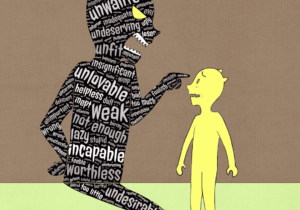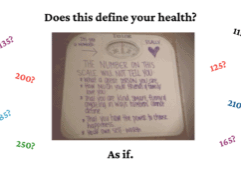7 Really Powerful and Trusted Steps to Practice Self Acceptance
Here’s an all too common story of how so many people do not practice self acceptance. Recently I woke up and stepped on the scale. The number I saw would have been a dream come true five years ago. It would have been a typical number for me in high school, or in my late 20’s. This number is also ten pounds above my goal weight. My first thought was “I don’t want to be here.”
It isn’t always the scale. It can be a credit card balance. A relationship. The status of the house: clean, dirty, or in need of a reality-TV level makeover. Most of us have at least one moment each day when we look at our email inbox, our medical test results, or our partner and think, “I don’t want to be here.”
Wanting More
It’s easy to mistake this feeling of dissatisfaction for motivation--I am so determined to reach my goals. This year I’m going to get into a size X. I’m going to double my income. I’m going to have the relationship of my dreams. If we ask ourselves why, the answer is often something like, “When I am fit enough, wealthy enough, or in love enough, then I will be happy.”
Popular culture and social media feed the idea that chasing more and better will lead to happiness. But take a minute to think about the most truly happy people you have known. People others want to be around. People who just make you feel good. Chances are, these people are the ones who accept themselves and others just as they are and who take time to savor the present moment. Happy people have goals and dreams too, but they realize that self acceptance and happiness are integral parts of the journey, not prizes to be earned at the end of it.
Therapists, philosophers, and researchers agree that accepting yourself as you are leads to happiness and improved mental health. So how do we work toward greater self-acceptance even if our health, our finances, or our relationships aren’t where we want them to be?
How to Practice Self Acceptance
1. Listen to your self-talk
You may have heard the advice, “If you wouldn’t say something to your best friend, don’t say it to yourself.” Self-talk centered around judgment and guilt does not motivate, it discourages us. When I tell myself “You messed up again. You’ll never get it right,” I am priming myself to give up. When negative thoughts will pop up, we can choose to mentally delete them and substitute a more productive one: “I am taking care of my health. I am getting fitter and stronger.” Negative thoughts will continue to pop up in our mental playlist, but we get to choose whether to skip them or to put them on repeat.
2. Separate the circumstances from the story
In any situation, there are circumstances, and there is our story. The circumstances are objective facts about what happened: My scale says 150 pounds. My credit card bill shows $9000 owed. Our story is a collection of thoughts, feelings, and opinions we tell ourselves about the circumstances.
When my scale says 150 pounds, the same as last week, I could tell this story: “No progress! It’s not fair! I exercised every day, ate salads, and skipped the pizza at the office. Nothing will ever work. I might as well just give up.” A different story might go: “Hmm, same as last week. I know I’ve been consistent on my food plan and workouts, so I’ll give it a little more time and see what happens.”
Even when we can’t change a circumstance, we can rescript our story to something that makes us feel more confident and empowers us to move forward.
3. Identify your circles of control
All of us have three circles of control: there are the parts of our lives we control completely: our own words and actions. Some parts of our lives we partially control, but other people or variables also have an influence: our schedule, our environment, our finances. Finally, there are events over which we have no control: other people’s words and actions, the weather, and global events. (We may influence these events, but we cannot directly control the outcomes.)
When we focus most of our time and attention on what we can control -- our own words and actions -- these are things that make you feel empowered. When we over-focus on events and factors beyond our control, we can feel discouraged and overwhelmed.
4. For circumstances within your circles of control, make a plan
If I’m dissatisfied with my weight, my job, or my relationships, I can make a plan and take action. Simple plans and small, do-able actions work best because we feel more confident we can carry them out, and success builds on success.
- For a health goal, I can include protein and vegetables at each meal.
- I can wait until I’m hungry to eat and stop when I’m satisfied, not stuffed.
If I focus on action steps I can control (eat protein and vegetables) rather than outcomes I can’t control (lose 10 pounds this month), I’m more likely to feel successful.
5. For circumstances outside your circles of control, change your story.
Life happens. From the trivial (traffic jam) to the catastrophic (loss of a job or loved one), we all face circumstances beyond our control. It’s normal and appropriate to feel frustration, grief, or any other emotion in response to these events. Even as we give ourselves space to vent or to grieve, we can choose the story we tell in a way that empowers us and paves the way for healing and growth, whenever we are ready.
Consider the difference between a story that goes, “This is so unfair. I must be the most unlucky person ever. Why do terrible things always happen to me?” and a story that says, “I am so sad and angry about what happened. That’s not what I wanted at all. I’m going to give myself time to process this, and when I’m ready, I will figure out what to do next.”
6. Give yourself permission to be where you are, right now
Even if you’re headed to bigger, better goals, it’s OK to be right where you are today.
This weight.
This bank balance.
This relationship status.
When we use GPS to route a trip, we need two locations: destination and current location. To route the next steps, we have to start right where we are, by accepting yourself as you are NOW.

Image by Steve Buissinne on Pixabay
7. Practice self acceptance by connecting to other people
There’s power in social connections. Online or in-person, from casual interactions to deep relationships, interacting with others boosts our sense of well-being. Talking to others also normalizes our experience. We’re never, ever the only person feeling this way or facing this challenge. Realizing that others have faced similar obstacles can encourage us to move forward.
Accepting ourselves and our current circumstances takes practice. But when you practice self acceptance, it can enhance your well-being and increase your motivation to work toward your goals. And it’s a practice you can start where you are right now.
Alyson Honeycutt helps women over 35 make peace with food and work with (instead of against) their bodies, so they can lead active, satisfying lives.
Find other articles written by Alyson on her coach profile. If you have ever said, "I know what I need to do, I just can't seem to do it," let Alyson show you how to shift your mindset and build sustainable habits that will help you create the life you want.







